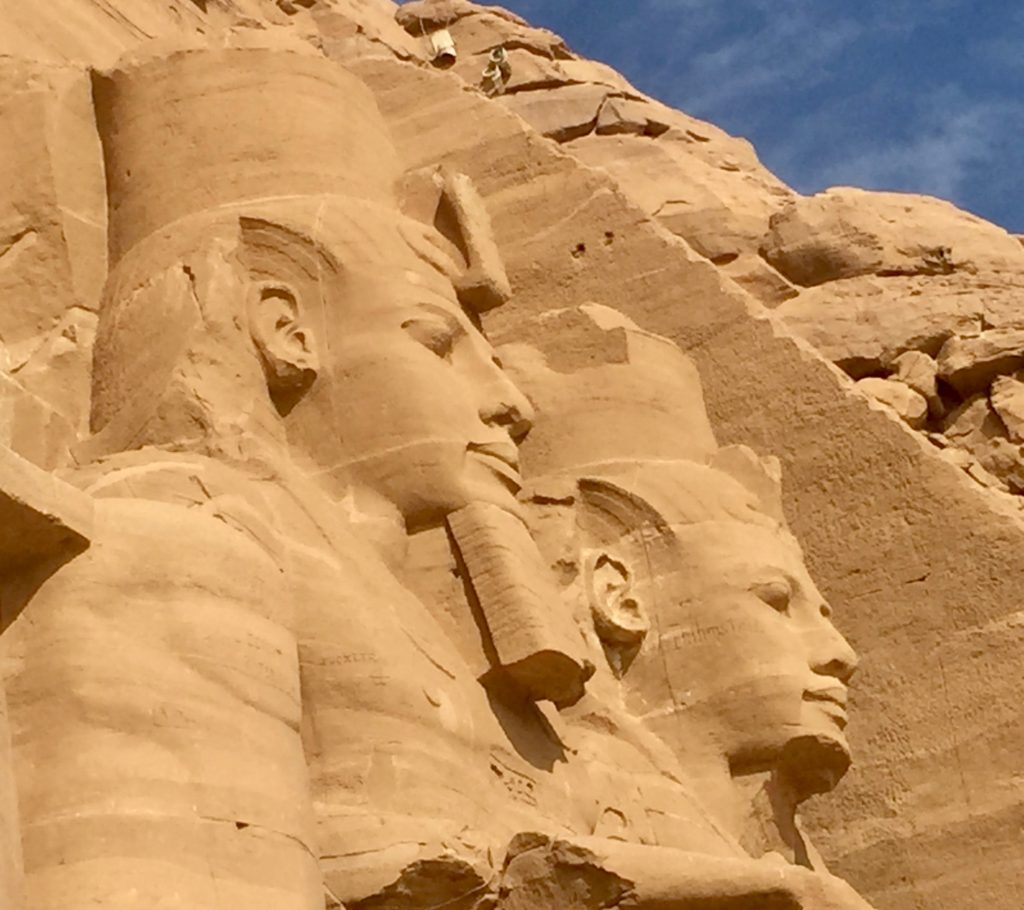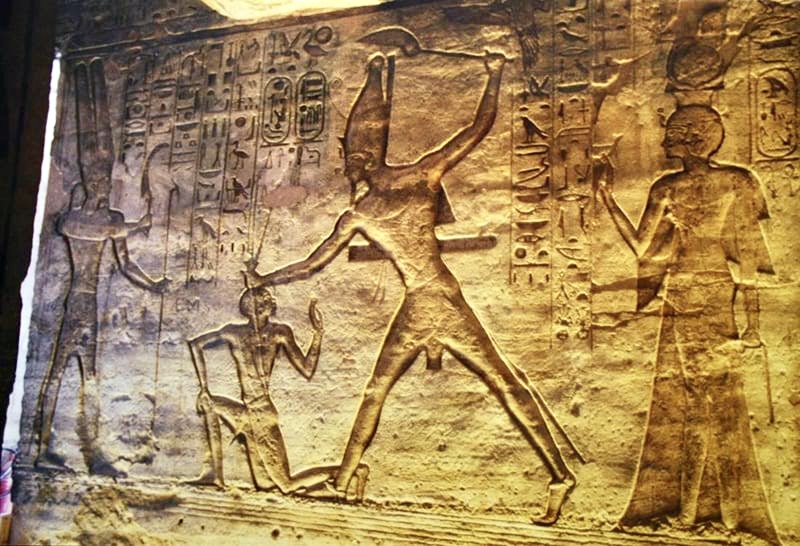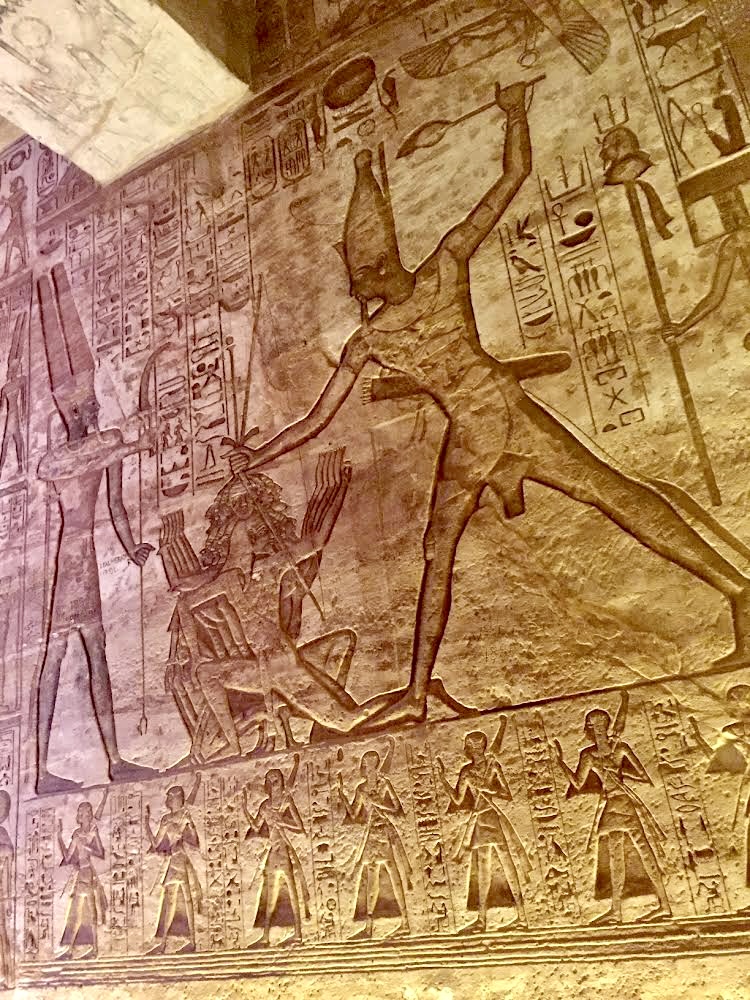Begin forwarded message:
Christmas Day 2020: I am in front of the Abu Simbel temple, south of Aswan:
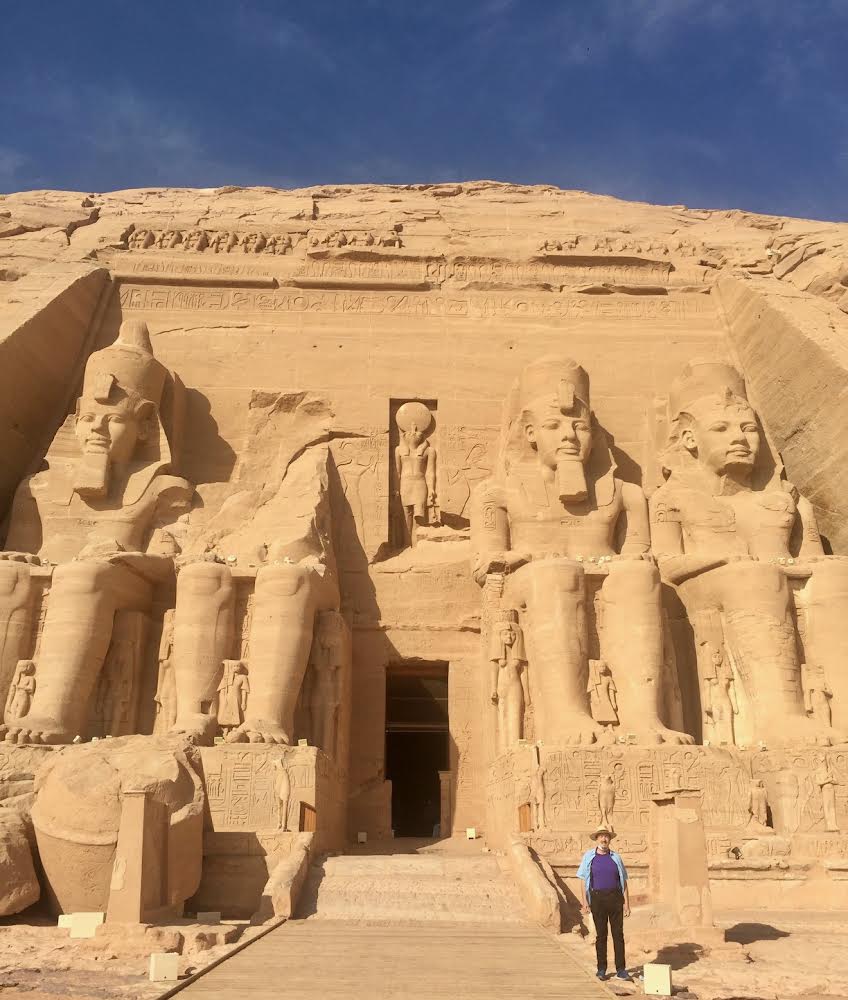
Abu Simbel was built some 3,500 years ago (around 1,300 B.C.) by Pharaoh Ramses II, the leading ruler of Egypt’s 19th Dynasty. Ramses II, also known as Ramses the Great, is among the most successful pharaohs of Ancient Egypt. He was the absolute ruler of the Egyptian Empire for an astounding sixty six years. He died when he was 90 or 91. According to Wikipedia: “He is often regarded as the greatest, most celebrated, and most powerful pharaoh of the New Kingdom, itself the most powerful period of Ancient Egypt.” Ramses II along with Cleopatra VI and King Tut, are the most famous pharaohs of ancient Egypt. As I wrote earlier, Ramses II was likely the pharoah who had to deal with Moses and the escape of the Hebrews from Egypt. If so, Ramses II is a character in the book of Exodus in the Old Testament.
There are four colossi of Ramses II as part of the entrance facade to the Temple. Each colossus is 33 ft tall. I have no idea why they are called a “colossus” and not just a “huge statue”. Here is a close up of two of the colossi.Above the transom of the Temple entrance is the patron god, Ra-Horus. This is a combo god of two separate gods: Ra the sun god and Horus the falcon headed god. See the sun disc above the falcon head.
Outside of Ramses II right leg is a statue of his beloved wife, Queen Nefertari and I am also outside of Ramses II right leg in the photo on the right, to give a size perspective.
In the next two photos, the statues in front of the facade are dramatic in their own right. However, in front view photos of the Temple, the statues do not stand out. These rows of statues are swallowed up by a flat perspective and the enormity of the facade as set out below.
The Temple is on the banks of Lake Nasser as seen from this photo below. The picture on the right was taken just inside the main Temple gate seen in the above photos.
The inside of the main chamber has all these support column, which of course, is another opportunity to worship the image of Ramses II. The column below is one of four statues (colossi?) in a row that face the corresponding four other statues on the other side of this chamber. This column/statue is on the RIGHT side of the chamber as you enter the Temple. The column blocking this photo below on right side (the column with the elbow sticking out) is the corresponding column on the other side of this modest sized chamber, modest size by temple standards:
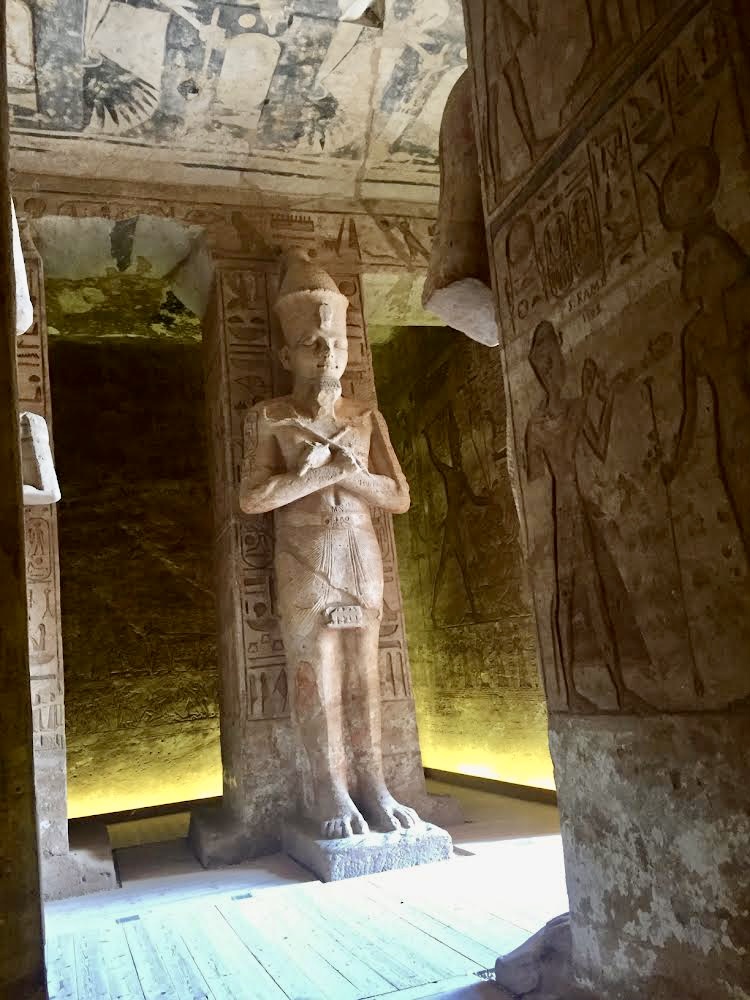
These support columns give you a chance to worship Ramses II not once, but many times. As you enter the temple, this is the LEFT side of the main chamber. The single statue above faces the first statue here. The passage way is in the center:
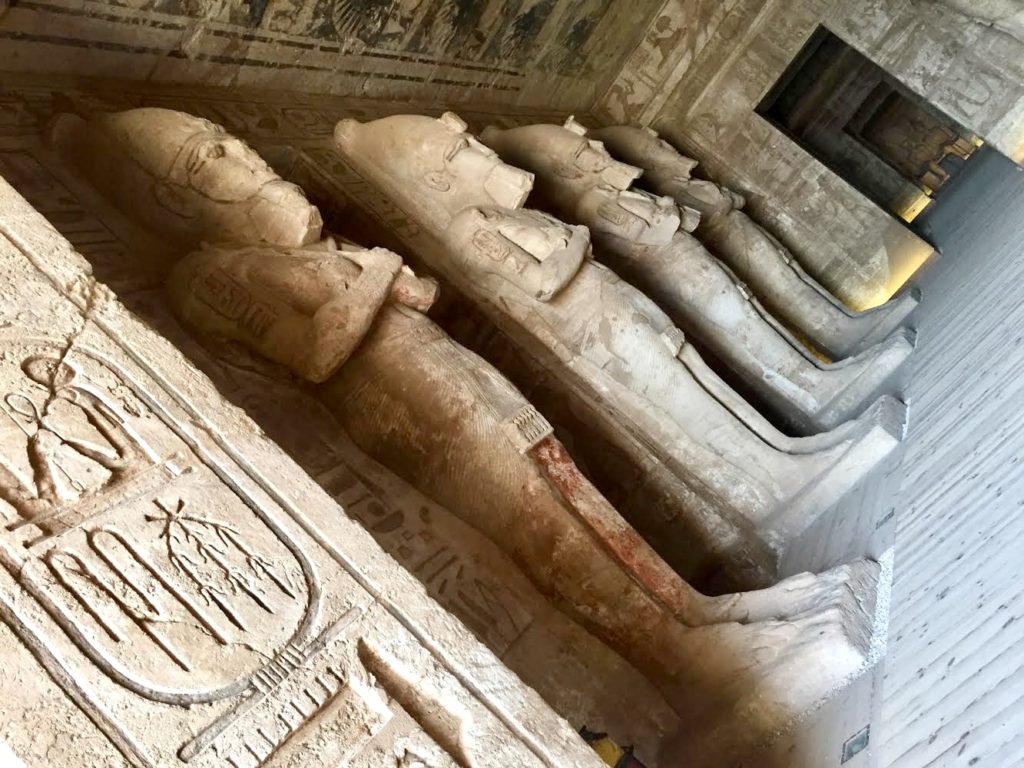
On the inside, this is my favorite photo of me from this trip. Below is a photo the interior of the main temple at Abu Simbel. In the background on the right, Ramses II us serving up some offering to Horus, the falcon headed god. On the left side, just behind me, Ramses is holding something up to the deity that I am obscuring. I think this partially-hidden god is Osiris. On the table between Ramses II and Osiris are offerings of lotus of perfume and other stuff. As a review, Osiris and his wife Isis are the Big Enchilada Gods, kind of like Zeus and Hera are to the Greeks. Isis is a bad choice for a Middle Eastern name in a 21st century context.
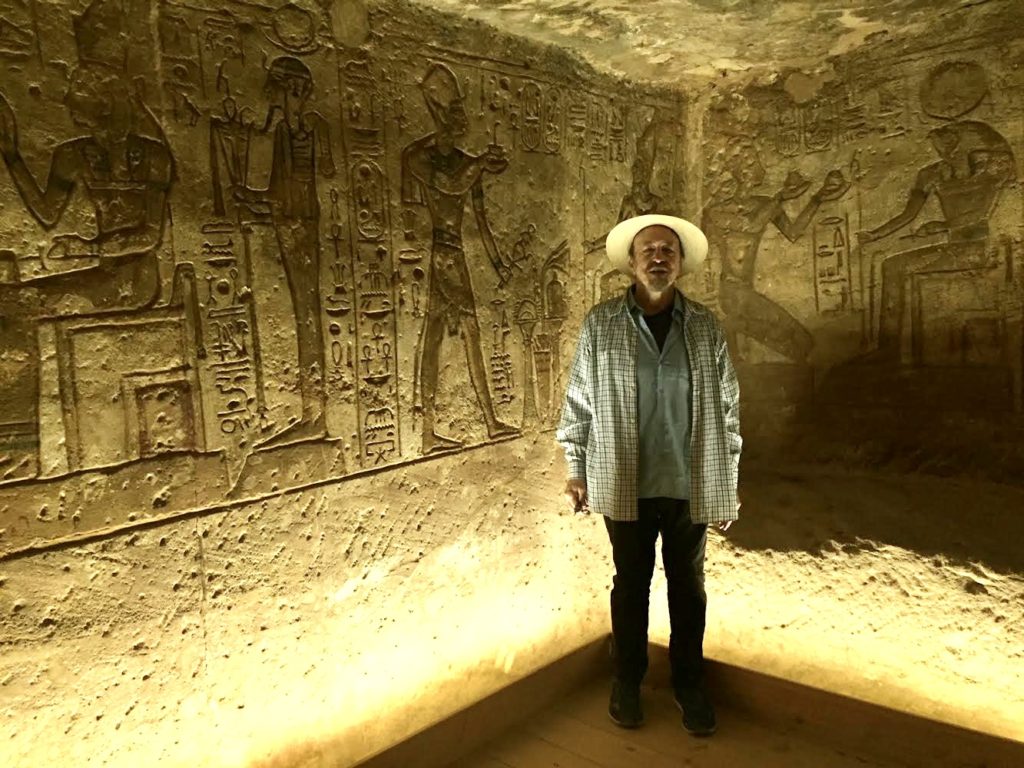
Below, Ramses II smiting a Hittite (Turkey) and a Libyan. The plaques used the word “smite”. I did not pick this word to describe Ramses II just whacking these guys. Since Ramses II had to be constantly vigilant and fighting threatening neighbor kingdoms. He is often depicted in his Temples personally smiting the enemy as both military propaganda and royal self-aggrandizement. There is all sorts of symbolism in every aspect of these depictions which the local viewers would understand.
Ramses II had a more gentle side. Here he is offering a pina colada to Horus:
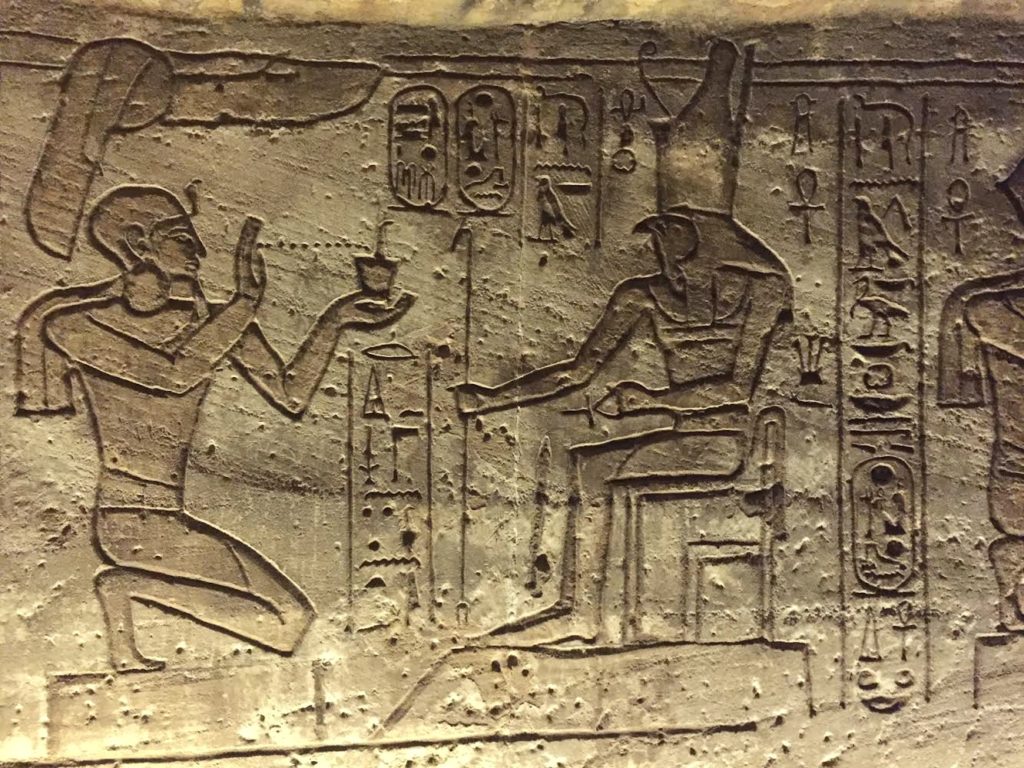
He and Nefertari offer lotus flowers to Isis:
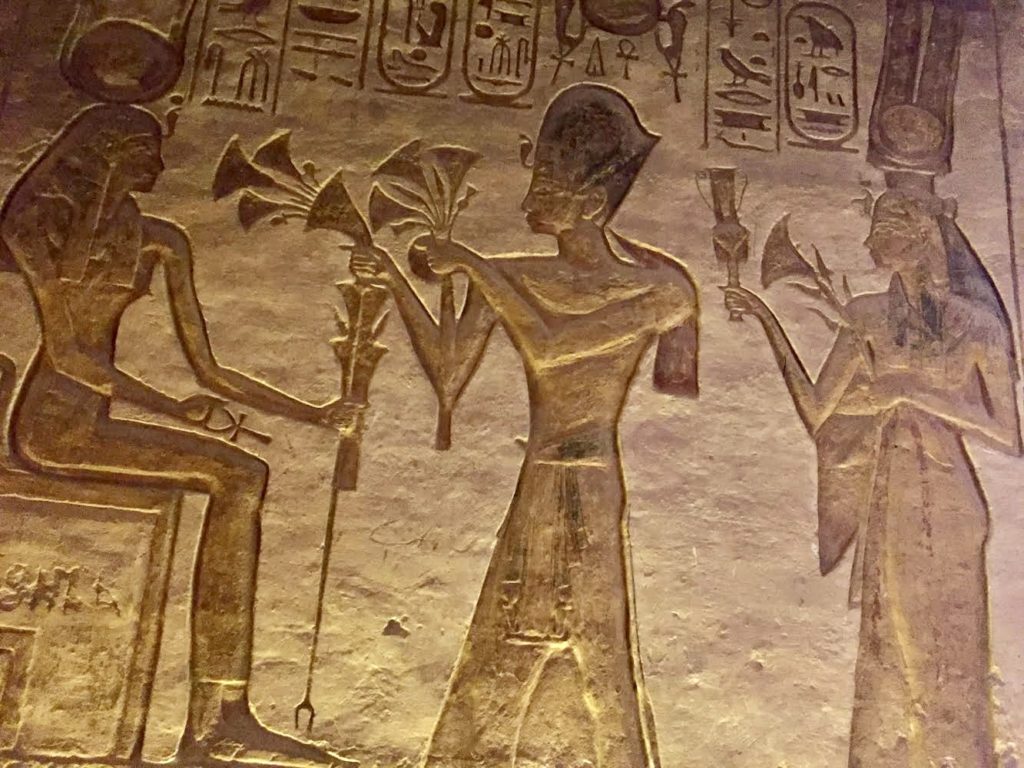
Weird Stuff:
Act II: Ramses, the God: Self Adoration of Ramses the God by Ramses the King. Ramses II had himself deified as a god. In Abu Simbel, there are etchings of Ramses the god mingling among other gods; such as Horus; Ra, the sun god; and Ptah, the creator god. Then there are carvings of Ramses II the pharaoh giving offerings to this pantheon of gods, including himself. I don’t have a photo of this scene, but Ramses II the pharaoh is thus giving offerings to himself, Ramses the god. It’s a flexible culture and religion.
Min-Amun. There is one great story about sexual prowess that no one can beat. However, the Greeks did imitate this story in a similar Greek fertility god, Priapus. According to the Encyclopedia Brittanica the Egyptian Min-Amun is “a god of fertility and harvest, embodiment of the masculine principle.”
The origin story goes that Min-Amun was an ordinary farmer. He was left behind in the village to guard the women folk when the king took off to some war with all the other male of the kingdom. When the king and soldiers returned, all the women were pregnant. Min-Amun swore up and down that he had no idea how that happened. The king didn’t buy it. As a punishment, the king ordered that one of Min-Amun’s hands be cut off. The next year the king went off on another war. Figuring that Min-Amun had learned a lesson, the king left him behind again to guard the women. The king returned to find all the women pregnant again. Not believing Min-Amun’s plea of innocence, the king cut off one of his feet. For the third war, the king was positive that Min-Amun would cause no harm this time, so left Min-Amun behind once again. The king returned to a village full of pregnant women. The king in his fury ordered Min-Amun stripped naked and then drawn and quartered. When Min-Amun’s clothes were torn away, everybody stopped and stared. All were in awe at this guy’s endowment. The king declared he could not kill such an amazing example of masculine prowess. The king turned Min-Amun into a god instead.
I could not make that story up. Here is Min-Amun on the walls of Abu Simbel. He has only one leg and one arm but is always depicted with an erection:

That’s it from Abu Simbel. Thanks for listening.
Zephyr the Sand Man
Related Ramses II articles are on this website (templesandtribes.net) These articles are under “Historic News” in Table of Contents. In addition, under “Travelogue-Egypt” There are other articles on Ancient Egypt. These articles below focus specifically on Ramses II: 1. Aswan Egypt Part I: Ramses II Protecting Egypt… 2. Ramses - Don’t Mess with Moses! 3. Sadly, Ramses II is the Fallen Ozymandias
